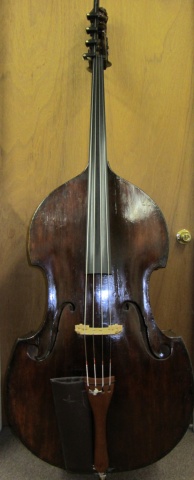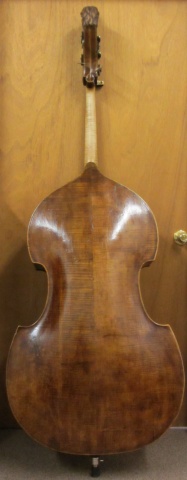 |
 |
 |
 |
Saxon/Bohemian School 18th-19th Century Orchestra Bass |
A very original old Germanic styled Bass |
| 18th-19th Century Round Back Orchestra Bass | |
| Upper Bout: 20 1/2" | Belly Length: 43 3/4" (Back to Button, 44") |
| Center Bout: 14 1/2" | String Length: 42" |
| Bottom Bout: 26 1/4" | Varnish: Golden Brown |
| Rib Depth: 8 1/2" at the bottom Block, gradually tapering to 6 7/8" at the Neck | |
| Top: 2-piece Spruce | |
| Back: 2-piece Flamed Maple Arched Round Back | |
| Ribs: Flamed Maple | |
| Neck / Scroll: Flamed Maple w/flame Maple Neck Graft | |
Features: Fully Set-up with a custom made Ebony C-Extension, fit around the Head only. The Bass is equally suited to be played in any capacity from Solo, to Orchestra to Jazz. It has the tone and feel to fit all styles with Bow or fingers. Note: When the Bass first arrived we had opinions that this was believed to be from the German/Bohemian region near Saxony but recently other opinions came in describing the Top and FFs as Klotz (Kloz) style and the Back arched in a manner after Stainer and the flush Rib-to-Plates (Top and Back) design to be Viennese in nature and not Bohemian. It was the Rib linings and round Back that pointed towards the German-Bohemian border area but we have been informed that several basses have been examined from 19th century Vienna that were more Germanic in style with 'outer linings' and 'round carved-backs'. Previously, this was not seen in Basses from the Viennese school of the 18th century. By the 1800's, the styles of both Stainer and Klotz and combinations of the two as well as the Italian schools were being copied all over central Europe. To try and identify origins from this period without other confirmed pedigree examples are nearly impossible. Recently I emailed collector of old Viol period instruments and was told rather the opposite; "The bass you have, however, has no resemblance whatsoever with either Stainer or Kloz or their schools". One dealer that I have known for years was on the same thought pattern as I was and thought this to be something from the Dresden area which is the capitol of Saxony. This is the general area that the Bass has lived in for over a century that we were able to trace so more than likely, we are back to our original thoughts on its origin. I have also seen a remotely similar bass with a lion head but the shoulders were not cut and was a larger bass with broader shoulders. The lion was different but it did have flush outer linings as this bass does but with a flat back. This seemed to be a slightly lesser bass in detail than this one but regardless, similar. That other bass is also attributed to the German school of the mid 19th century. The shoulders and lower bouts of this Bass were cut down some time ago, possibly in the latter part of the 19th century as the work looks old. Of the 5 old repair labels in the bass, one is dated 1886 and another older label too faded to read. The current shape of these shoulders are from the late 19th century as the purfling shows signs of the bass having a much broader outline, common for the period in which this was made. Regardless of all of the questions raised in regards to an exact origin or pedigree, it is a beautiful sounding and easy playing bass with plenty of power, depth and tone color. For this reason, we added the C-Extension for full all around use. Note: This Bass has been Sold.. |
|
| A beautiful Lion head Scroll with modified tuning gears and a Custom Ebony C-Extension. |
 |
Copyright ©
1998-2013 Ken Smith Basses, LTD. (All rights reserved) ALL PRICES AND SPECS SUBJECT TO CHANGE WITHOUT NOTICE |
 |